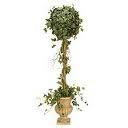“A delightful sight for me, you see, is an enchanting, whimsical topiary tree”.
On my writing desk, nestled between some of my favorite, dog eared books, sits a much loved, shabby, topiary tree. Soft red and white ribbons dangle lazily from its midpoint as it lounges, snuggled down, in a little vintage urn filled with dried rosebuds and velvety green moss. It is here where my tree happily keeps company with lots of other special bits and pieces of my long and wonderful life. Photos of my dear grandchildren convey my present joys, and a lovingly made clay dinosaur, poinsettia paper weight and a set of affectionately carved wooden houses are gifts from children who have since grown to make me very proud. This is also where I enjoy my favorite past time; writing. Like all of my other treasures, my topiary tree has a quiet beauty that brings inspiration and comfort to me as I silently sit, remembering times past and putting my precious thoughts down in my journal.
I don’t exactly know why they so intrigue me, these beautifully sculptured foliages called topiaries, but they do. Traditionally made by delicately pruning Box, Myrtle and Bay Laurel trees into charming geometric or animal shapes they are easily spotted. When I spot one, a quiet smile creeps on my face and my spirits soar! Not surprisingly, my home is filled with countless variations of them. They hang in art form, on the walls of my entry way to warmly welcome guests and family into our peaceful home. Displayed in large outdoor urns, our wooden deck serves as backdrop for tall evergreen topiaries as they stand sentry, carefully shading my more delicate flowers from the harsh Texas sun.
My husband and I often open our home to celebration, so, like old friends, my best dressed topiaries visit my dining room table regularly, always stylishly clad in whatever is called for by the season. Sometimes they give support to the hot summer months and are dressed in sunflowers or jasmine and sometimes their lovely orbs are draped with fall leaves and garnished with tiny little pumpkins. Decorating them brings me pleasure and reassurance that yet another glorious season is ready to be enjoyed by all!
Whether exquisitely sculpted foliage, protecting a stately English garden, or made of rambling rosemary, perched in a crumbling clay pot atop a lonely kitchen window sill, I find the topiary tree captures my attention and allows my mind to wander to times past. Perhaps the comfort I sense from their mere presence stems from their ancient history. With this in mind, I made a decision to research their past to find out a little bit more about their origination.
The word “topiary” comes from the Latin "topiarius", meaning ornamental landscaper. A treasured gift to us from the Romans, Greeks and Persians, the topiary tree has been with us for thousands of years. Caesar first used bushes and trees of box, myrtle and bay in a sculpted form of beautifully trimmed hedges in his meticulously landscaped Roman gardens. His gardeners began to experiment with geometrical shapes and designs to form intricate walkways which became known as mazes. Ancient travel allowed the spread of this unique art form to Japan where it was gradually altered and took on a shape more like miniature trees. They call them bonsai.
Popularity of topiary spread and flourished in 17th century England as the aristocrats and royals fashioned in the Franco-Dutch gardening style. However, when Alexander Pope, a famous London literary scholar, wrote a critical piece on the topiary, poking fun at all the mazes and shapes being created and displayed, the rich lost interest and removed the topiary from their gardens. Local cottages kept it alive, however, by turning the practice into family heirlooms.
Nearing the 19th century, John Loudon, an admired Scottish botanist and garden magazine editor, voiced his concern about the diminished use of topiary trees. Between his trusted word and the renewed national self confidence known as the American Renaissance, the practice was quickly resumed and the eye catching beauty of the topiary tree once again returned.
Topiary trees can be found almost everywhere and are used to help celebrate special occasions throughout all corners of the world. They can be simply made of rosemary and sage to add an irresistible Tuscan flair to open-air kitchens, gardens and patios. Topiaries with roses and ivy delicately clinging from frames of hearts or circles make even the loveliest of all weddings more memorable. And when planted in large, stately urns and placed on either side of an ordinary front entrance, coned shaped ivy topiary trees instantly add a refinement and charm otherwise lacking.
Most of the time, the word topiary brings to mind that of a single tree. No so! Topiary can also be the beautifully sculpted foliage that you see in the form of mazes, animals or geometric shapes. This makes sense when realizing the origin of the word topiary which is "topiarius" (Latin for ornamental landscaper). The art form was influenced originally from the Romans, Greeks and Persians.
Topiary also consists of evergreen shrubs, bushes, and trees that are clustered together to form shapes such as an elephant, clouds, dogs, dinosaurs or even people. These shapes, since they are not loose and leafy, can remain as sculpted with only the occasional pruning required.
Whatever your preference, topiaries add a sense of fun and humor to a home and are most always a wonderful topic of conversation. I suggest you add one or two to yours so you can realize the same enjoyments as I get from mine. Enjoy, and happy fall to you all!


Very pretty topiary!
ReplyDeleteSherry